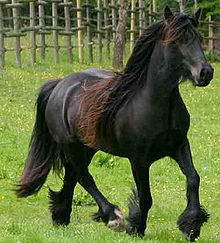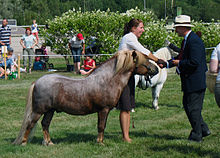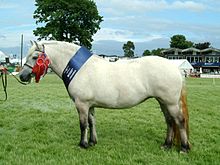- Mountain and moorland pony breeds
-
Mountain and moorland or M&M ponies form a group of several breeds of ponies and small horses native to the British Isles. Many of these breeds are derived from semi-feral ponies kept on moorland or heathland, and some of them still live in this way, as well as being kept as fully domesticated horses for riding, driving and other draught work, or for horse showing.
Mountain and moorland classes at horse shows in the British Isles cover most of the breeds; however, the four closely related Welsh breeds often form their own classes.
Traditionally the modern mountain and moorland ponies have been regarded as including nine breeds (the four Welsh types being counted as one). However, in recent decades at least two further types have been recognised: the Eriskay and the Kerry bog pony. Larger native British Isles horses (such as the various large draught breeds) are not regarded as belonging to the mountain and moorland group.
Contents
Characteristics
Mountain and moorland ponies are generally stocky in build, with flowing mane and tail. They are very hardy and are "good doers", needing relatively little food to live on. They are prone to obesity and if allowed to graze freely on lush forage may develop related health problems, including laminitis. The various types range from about 11 hands (44 inches, 112 cm) to over 14 hands (56 inches, 142 cm). Shetlands are smaller, not to exceed 10.2 hands (42 inches, 107 cm).[1] Shetlands are measured in inches.[2] Some breeds, such as the Exmoor, are uniform in colour and pattern, but others permit a wide range of colours. However, the Shetland is the only M&M breed that can be skewbald or piebald.[citation needed], though even Shetlands cannot be "spotted."[1]
Semi-feral ponies
Several types of mountain and moorland ponies still live in a semi-feral state on unenclosed moorland or heathland. These areas are usually unfenced common land, on which local people have rights to graze livestock, including their ponies. Generally the mares are turned out for the whole year, living in small groups, which often consist of an older mare, several of her female offspring, and their foals (which are born in spring, after a pregnancy of eleven months). Small numbers of stallions are allowed to join the mares for a few weeks in spring or early summer. Each stallion then gathers a harem of mares and their foals to form a larger group of up to twenty or so. The foals and mares are rounded up in autumn, when the colts and some of the fillies are removed for sale. The remaining fillies are usually branded to indicate ownership. Some geldings may also be turned out. Ponies still kept in this way include New Forest, Exmoor, Dartmoor and Welsh. Each of these breeds also has a population kept as fully domesticated animals.
Showing
In horse shows mountain and moorland classes are divided into two subsections: small breeds and large breeds, although the four Welsh types are often shown in their own classes instead. They are overseen by the relevant breed society, and by the British Show Pony Society.
Mountain and moorland breeds
Small breeds
- Shetland pony, from the Shetland Isles off the northern tip of Scotland.
- Exmoor pony, from Exmoor in Somerset and Devon in south-west England.
- Dartmoor pony, from Dartmoor in Devon in south-west England.
- Welsh Mountain pony (Section A) and Welsh pony (Section B), from Wales
- Eriskay pony, from the island of Eriskay in the Hebrides. Formerly more widespread, and perhaps largely absorbed into the Highland.
- Kerry bog pony, from south-west Ireland.
Large breeds
- Connemara pony, from County Galway in western Ireland.
- Highland pony, from Scotland. Larger, mainland types known as the Garron.
- Dales pony, from the eastern Pennines of northern England.
- Fell pony, from Cumbria in north-western England.
- New Forest pony, from the New Forest in Hampshire on the south coast of England.
- Welsh pony (Section C) and Welsh Cob (Section D), from Wales.
- Galloway pony, from Scotland and northern England. Extinct: perhaps absorbed into the Highland and Fell.
Showing mountain and moorland ponies
Turnout
Mountain and moorland ponies are shown in their "native" state, and are not trimmed or plaited (braided). In reality a little light trimming is commonplace, for example to show off the fine head of the Connemara, and Welsh ponies often have their manes pulled to a length of about six inches. In some cases, trimming is necessary - if a small breeds pony's tail was left to grow unchecked it would become matted with mud and the pony could stand on it, potentially causing injury to itself or its rider.
Bridles are plain and workmanlike, without coloured browbands or embellishments. A double bridle or a pelham bit is used in open classes, while a snaffle bit is used in novice classes.
Rider dress
Riders wear tweed jackets, canary or buff breeches, shirt and tie, plain gloves and a navy hat. Adult riders on large breed ponies wear long boots with garter straps. Adult riders on small breed ponies must wear jodhpur boots with jodhpur clips. Children wear jodhpur boots with jodhpur clips. Show canes or plain leather whips are carried.
The use of spurs is forbidden in all mountain and moorland classes.
Part-bred classes
Many shows hold classes for part-bred mountain and moorland horses and ponies. In these cases the horses are turned out according to type - for example hunter pony or riding pony.
Conservation grazing
The mountain and moorland breeds are well-adapted to surviving on poor-quality grazing. This makes them suitable for use in conservation grazing, the use of livestock to manage land of high ecological value in a natural way. Pony breeds used in this way in Britain include the Exmoor, Dartmoor, Welsh and New Forest (as well as some similar ponies from other parts of Europe such as the Icelandic and Konik).
See also
References
- ^ a b "Breed Standard". UK Shetland Pony Stud-Book Society. http://www.shetlandponystudbooksociety.co.uk/about_breed/breed.aspx. Retrieved June 2011.
- ^ "History of the Shetland". The Trawden & District Agricultural Society. http://www.trawdenshow.co.uk/the-show/horses/shetland/. Retrieved June 2011.
External links
Categories:- Types of horse
Wikimedia Foundation. 2010.



